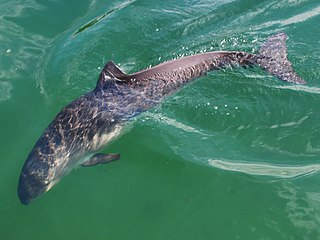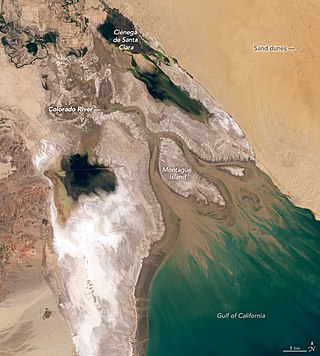
Porpoises are small dolphin-like cetaceans classified under the family Phocoenidae. Although similar in appearance to dolphins, they are more closely related to narwhals and belugas than to the true dolphins. There are eight extant species of porpoise, all among the smallest of the toothed whales. Porpoises are distinguished from dolphins by their flattened, spade-shaped teeth distinct from the conical teeth of dolphins, and lack of a pronounced beak, although some dolphins also lack a pronounced beak. Porpoises, and other cetaceans, belong to the clade Cetartiodactyla with even-toed ungulates.

Sciaenidae is a family of ray-finned fishes belonging to the order Acanthuriformes. They are commonly called drums or croakers in reference to the repetitive throbbing or drumming sounds they make. The family consists of about 293 to 298 species in about 66 or 67 genera.

The Gulf of California, also known as the Sea of Cortés or Sea of Cortez, or less commonly as the Vermilion Sea, is a marginal sea of the Pacific Ocean that separates the Baja California Peninsula from the Mexican mainland. It is bordered by the states of Baja California, Baja California Sur, Sonora, and Sinaloa with a coastline of approximately 4,000 km (2,500 mi). Rivers that flow into the Gulf of California include the Colorado, Fuerte, Mayo, Sinaloa, Sonora, and the Yaqui. The surface of the gulf is about 160,000 km2 (62,000 sq mi). Maximum depths exceed 3,000 meters (9,800 ft) because of the complex geology, linked to plate tectonics.

The swim bladder, gas bladder, fish maw, or air bladder is an internal gas-filled organ that contributes to the ability of many bony fish to control their buoyancy, and thus to stay at their current water depth without having to expend energy in swimming. Also, the dorsal position of the swim bladder means the center of mass is below the center of volume, allowing it to act as a stabilizing agent. Additionally, the swim bladder functions as a resonating chamber, to produce or receive sound.

The vaquita is a species of porpoise endemic to the northern end of the Gulf of California in Baja California, Mexico. Reaching a maximum body length of 150 cm (4.9 ft) (females) or 140 cm (4.6 ft) (males), it is the smallest of all living cetaceans.

The kaluga, also known as the river beluga, is a large predatory sturgeon found in the Amur River basin. With a maximum size of at least 1,000 kg (2,205 lb) and 5.6 m (18.6 ft), the kaluga is one of the biggest of the sturgeon family. Like the slightly larger beluga, it spends part of its life in salt water. Unlike the beluga, this fish has 5 major rows of dermal scutes and feeds on salmon and other fish in the Amur. They have gray-green to black backs with a yellowish green-white underbelly.

Cetacean bycatch is the accidental capture of non-target cetacean species such as dolphins, porpoises, and whales by fisheries. Bycatch can be caused by entanglement in fishing nets and lines, or direct capture by hooks or in trawl nets.

The Colorado River Delta is the region where the Colorado River flows into the Gulf of California in eastern Mexicali Municipality in the north of the state of Baja California in northwesternmost Mexico. The delta is part of a larger geologic region called the Salton Trough. Historically, the interaction of the river's flow and the ocean's tide created a dynamic environment, supporting freshwater, brackish, and saltwater species. Within the delta region, the river split into multiple braided channels and formed a complex estuary and terrestrial ecosystems. The use of water upstream and the accompanying reduction of freshwater flow has resulted in the loss of most of the wetlands of the area, as well as drastic changes to the aquatic ecosystems. However, a scheme is currently in place which aims to rejuvenate the wetlands by releasing a pulse of water down the river delta.

The yellowfin cutthroat trout is an extinct subspecies or variety of the cutthroat trout, a North American freshwater fish.

The Pacific ladyfish, also known as the Pacific tenpounder and machete, is a species of ray-finned fish in the genus Elops, the only genus in the monotypic family Elopidae. The Pacific ladyfish can be found throughout the southwest U.S. and other areas in the Pacific Ocean.

Argyrosomus regius, also known as the meagre, croaker, jewfish, shade-fish, sowa, kir, corvina, salmon-bass or stone bass, is a species of fish of the family Sciaenidae. This large fish has a pearly-silver to brownish coloration and a yellow-coloured mouth. It is native to the eastern Atlantic Ocean, as well as the Mediterranean and Black Seas.

Functional extinction is the extinction of a species or other taxon such that:
- It disappears from the fossil record, or historic reports of its existence cease;
- The reduced population no longer plays a significant role in ecosystem function;
- The population is no longer viable. There are no individuals able to reproduce, or the small population of breeding individuals will not be able to sustain itself due to inbreeding depression and genetic drift, which leads to a loss of fitness.

The Environmental Investigation Agency (EIA) is an international NGO founded in 1984 in the United Kingdom by environmental activists Dave Currey, Jennifer Lonsdale and Allan Thornton. At present, it has offices in London and Washington, D.C. The EIA covertly investigates and campaigns against environmental crime and abuse.

Evolutionarily Distinct and Globally Endangered (EDGE) species are animal species which have a high 'EDGE score', a metric combining endangered conservation status with the genetic distinctiveness of the particular taxon. Distinctive species have few closely related species, and EDGE species are often the only surviving member of their genus or even higher taxonomic rank. The extinction of such species would therefore represent a disproportionate loss of unique evolutionary history and biodiversity.
The Chinese bahaba, also known as the giant yellow croaker, is a critically endangered species of marine and brackish water fish in the family Sciaenidae. It is a large fish, reaching lengths up to 2 m and weights of 100 kg (220 lb). It is found on the coast of China, from the Yangtze River estuary southwards to the Pearl River estuary, including the waters of Hong Kong and Macau. Its natural habitats are shallow seas, subtidal aquatic beds, rocky shores, and estuarine waters.
Bahaba is a genus of marine ray-finned fishes belonging to the family Sciaenidae, the drums and croakers. These fishes are found in the Indo-West Pacific region.

The baiji is a possibly extinct species of freshwater dolphin native to the Yangtze river system in China. It is thought to be the first dolphin species driven to extinction due to the impact of humans. This dolphin is listed as “critically endangered: possibly extinct” by the IUCN, has not been seen in 40 years, and several surveys of the Yangtze have failed to find it. In China, the species is also called the Chinese river dolphin, Han river dolphin, Yangtze dolphin and whitefin dolphin. Nicknamed the "Goddess of the Yangtze", it was regarded as the goddess of protection by local fishermen and boatmen. It is not to be confused with the Chinese white dolphin or the finless porpoise. This is the only species in the genus Lipotes.

An endangered species is a species that is very likely to become extinct in the near future, either worldwide or in a particular political jurisdiction. Endangered species may be at risk due to factors such as habitat loss, poaching, and invasive species. The International Union for Conservation of Nature (IUCN) Red List lists the global conservation status of many species, and various other agencies assess the status of species within particular areas. Many nations have laws that protect conservation-reliant species which, for example, forbid hunting, restrict land development, or create protected areas. Some endangered species are the target of extensive conservation efforts such as captive breeding and habitat restoration.

Sea of Shadows is a 2019 documentary about environmental activists, the Mexican Navy, marine scientists and undercover investigators trying to prevent the extinction of the vaquita, a species of porpoise and the smallest whale in the world, by pulling gillnets, doing research, and fighting back Mexican cartels and Chinese mafia who are destroying ocean habitats in their brutal pursuit to harvest the swim bladder of the totoaba fish, known as the "cocaine of the sea". The 1 hour and 44 minutes long film is directed by Richard Ladkani.

The Yangtze finless porpoise is a species of toothed whale in the family Phocoenidae, the porpoise family. It is endemic to the Yangtze River in China, making it the country's only known freshwater cetacean following the possible extinction of the baiji, a freshwater dolphin also native to the Yangtze. The Yangtze finless porpoise is considered endangered and it is estimated that only about 1,000 remain. This small toothed whale faces many of the same threats as the baiji: High human activity on the Yangtze, such as illegal fishing, pollution, boat traffic, and dam construction. Due to the rapidly declining population of the species, the Chinese government and conservation charities are working to help save it from extinction.




















